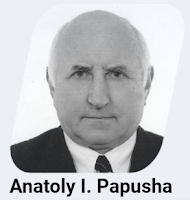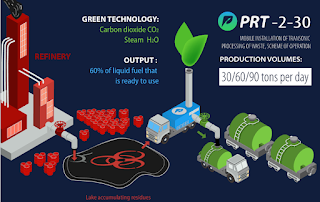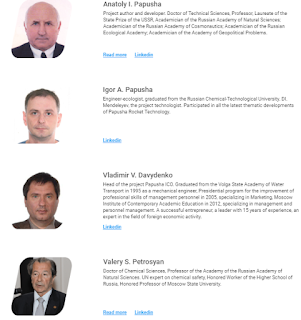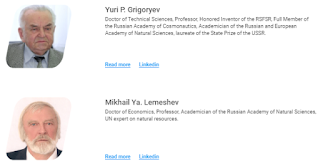
The world's first rocket and space technology for fuel production using refined fuel, proposed by the Russian Academy of Natural Sciences Anatoly Papushi, who developed the Buran program or visited https://papusha.io/ for more information.
In the 1980s, Anatoly Ivanovich. The famous scientist Pachusha, a professor of machine building, a laureate. In the 1980s, the most powerful rocket engine in the world was created for the Soviet space program. To test this rocket engine, as a member of a group of AI scientists. Papusa creates the world's largest combustion chamber - carbon monoxide after afterburning (CO). The rocket engine, created in the exhaust gas from the jet stream, contains 1000 kg of carbon monoxide per second. Within 180 seconds, it releases the same amount of carbon monoxide as all of Moscow's emissions for one day.
To truly burn carbon monoxide, for the first time AIPapusha applied a new type of transonic multistage combustion (speed ~ 1000 m / s) with
very high water and oxygen inputs. This makes it possible to achieve a thousand-fold reduction in carbon dioxide emissions. monoxide from 1000 to 1 kg / s. For the development of AI Papushi, he was awarded the State Prize for the Soviet Union.
Who is he, Anatoly Ivanovich Papusha ???

Anatoly Ivanovich Papusha, a leading expert in the field of rocket and aerospace industry. He has been working in large branches for more than 50 years. Director of the Department of Ecology of the International Fund of Slavic Culture and Writing. Academy of the Academy of Natural Sciences of the Russian Academy of Sciences (RANS). It is estimated from the state premium of the USSR.
What is Papusha AI ????
Papush A.I. - one of the brightest representatives of the legendary Soviet national rocket and space industry, as well as the disciples and followers of the brilliant machine developer of the spaceship V.P. Glushko.
During the development of the Soviet space program "Energia-Buran" a car was created that burned 10 tons of fuel for 10 seconds. Machine testing is very dangerous for the entire ecology of the Moscow region. Papush A.I. created a unique complex that was built in Khimki, Moscow Region.
The base module in Khimki
The complex allows to completely neutralize harmful emissions and test engines that are made near the development site.
Innovation of transonic combustion was first applied to the use of combustion products from large rocket engines. Further successes in the field of innovations opened up prospects for solving the most urgent environmental problems. This technology is included in the list of "PCB Destruction Technology Survey Not Open Burning PCB" by UNEP (First Edition, August 2000) with the author's name "Papusha Rocket Technology" (PRT), visit https://Papusha.io/file/Whitepaper_ENG.pdf
How it works?

Countries and companies engaged in processing will receive the following benefits using Rocket Papusha technology:
- to receive liquid cargoes from unused raw materials;
- improvement of the environment;
- very effective processing of heavy oil, etc.
Benefits of installing domestic workers:
- Efficiency. Small blocks PRT allow to receive up to 60% of liquid fuel from the total weight of the processed mass. - Expenses. Production costs for installation of 1 PRT from 950 000 $.
- Payback. The average return time of 1 PRT-2 unit is 5-7 months.
- Oil refineries have the following advantages when using the technology "Papusa Missile technology:
- Obtaining expensive gasoline and diesel fuel from oil refining waste. Cost savings due to the refusal to store the contents and sedimentation tanks.
- Improvement of the environment.
What is Papus Rocket ICO ???
Papusa ICO Rocket is the latest technology for the destruction of remnants of oil refineries around the world. Instead of destroying flora and fauna, refineries receive gasoline and diesel for sale.
ICO PRT produces low-capacity processing plants for the processing of fuel oil and the production of liquid fuels using transonic combustion technology. Each oil refinery in the world produces 1.35 million tons of residues. Depending on the capacity, the PRT-2 unit processes 30-90 tons of waste per day. The market needs tens of thousands of PRT-2 units.
It is important to mention that we are talking only about the utilization of new residues, which allows us not to cause additional pollution on our planet. Accumulation of deposits and lakes requires volumes that are several times higher than this.
The ICO Papusha missile is based on three main components:
- The patented technology of transonic combustion (included in the list of UNEP "Review of the current burning of PCBs in combustion destruction technology" (first edition, August 2000) with the name of the author of the "Paput's Missile Technology" (PRT)).
- Development of conversions based on high-tech solutions used for missiles and space and aviation equipment.
- Has scientific and methodical developments in the rocket and space and aviation space. Project documentation is carried out by representatives of the defense industry, the experimental base and experience of using the cauterizing industry of the Transikik in conditions of extreme neutralization and the conditions of very toxic substances.
The purpose of Papushi
Our common goal is to maintain and improve the environmental situation throughout the world for us and our children.
Block PRT, developed by Academician Papusha
● Small size
● Low cost of creation and operation
● Reliability of equipment
● High efficiency and quick payback period
● Versatility and autonomy
● Low cost of creation and operation
● Reliability of equipment
● High efficiency and quick payback period
● Versatility and autonomy
More information on ICO
- Date: August 22 - October 22
- Tag Name: PRT
- Blocking chain: Ethereum
- Standard: ERC20
- Minimum amount: 100 PRT
- Soft cover: no
- Hard cover: 13 500 ETH
- Accepted: ETH
- Total tokens: 100,000,000
- Available for sale: 75%
- Token cost: 1 ETH = 3500 PRT [
SELL DETAILS TOKEN
- "Private sale": 01/06/2018 - 08/22/2018
- ICO: 08/22/2018 - 10/22/2018
- Tag Name: PRT
- Blocking chain: Ethereum
- Standard: ERC20
- Hard cover: 13500 ETH
- Total number of tokens: 100 000 000
- Available for sale: 75%
- Price per click: 1 ETH = 3500 PRT
Unsold tokens will be burned!
Distribution of PRT tokens

Road map
2016
● Beginning of scientific calculations for refining petroleum products,
● Testing the technology at the base stand in Dolgoprudniy and
● Testing completed successfully, further development and improvement of the technology.
● Beginning of scientific calculations for refining petroleum products,
● Testing the technology at the base stand in Dolgoprudniy and
● Testing completed successfully, further development and improvement of the technology.
2017
● Completion of calculations, systematization of the results obtained,
● Preparation of the business plan, search for partners.
● Preparation of the business plan, search for partners.
2018, Quarter 1
● Preparing for the ICO:
● Forming a team, drawing up technical documentation,
● Developing an intellectual contract and a symbolic economy.
● Forming a team, drawing up technical documentation,
● Developing an intellectual contract and a symbolic economy.
2018, quarter 2
Launching ICO:
● Marketing campaign,
● Carry out a private round of sales.
● Carry out a private round of sales.
2018, quarter 3
● ICO Pachusha missile technology,
● PRT token introduction to exchanges and
● Development of maintenance documentation.
● PRT token introduction to exchanges and
● Development of maintenance documentation.
2018, fourth quarter
● Production and purchase of necessary equipment and components,
● Creation and adjustment of the first unit PRT-2-30 and
● Certification, obtaining of technical specifications for connection.
● Creation and adjustment of the first unit PRT-2-30 and
● Certification, obtaining of technical specifications for connection.
2019
● Launch of mass production of PRT-2 units, first sales,
● Development of modules for the processing of brown coal and
● Work to adapt and introduce a gas generator that provides cheap electricity for mining.
● Development of modules for the processing of brown coal and
● Work to adapt and introduce a gas generator that provides cheap electricity for mining.
Team of developers and scientists

Advisers

Conclusion
The project began in the 1980s. The technology was developed for the needs of the Soviet space program. Hundreds of millions of dollars were spent on testing and building a complex to neutralize Buran engine emissions. However, in the future, after the collapse of the USSR, funding
was cut off, and Burana's program was frozen. Since then AI. Papushe managed to find a new application of his technology, which is very much in demand today. Our road map shows the main stages of the project
For more information, please join us in the Telegram group https://t.me/PapushaBounty
Subscribe to us at:
Official website: https://papusha.io/
Technical documentation: https://papusha.io/files/Whitepaper_ENG.pdf
Telegram: https://t.me/PapushaBounty
Twitter: https://twitter.com/papushatech
Instagram: https://www.instagram.com/papushaico/
User Name: phatpharm20
Link to profile: https://bitcointalk.org/index.php?action=profile;u=2038562
Eth Address: 0x1cff5da802703815aea69be79491c636369d0d1f
- Get link
- X
- Other Apps
- Get link
- X
- Other Apps
Comments